Image Processing of UAV Imagery for River Feature Recognition of Kerian River, Malaysia
Abstract
1. Introduction
2. Materials and Methods
2.1. Study Area
2.2. Flight Mission
2.3. Image Processing of UAV Images
2.3.1. Implementation of Bilateral Filter
2.3.2. Clustering of Pixels Using k-Means Clustering Method
2.3.3. Thresholding of Clustered Images
2.4. Evaluation of Image Processing Algorithm Effectiveness
3. Results
4. Discussion
4.1. Variation in Water Flow Area and Vegetation Cover
4.2. Quantitative Evaluation
4.3. Advantages and Limitations of UAV in River Feature Recognition
4.4. UAV Imagery in Landscape of Kerian River and other Malaysian Rivers
5. Conclusions
Author Contributions
Funding
Conflicts of Interest
References
- Chan, N.W. Increasing flood risk in Malaysia: Causes and solutions. Disaster Prev. Manag. Int. J. 1997, 6, 72–86. [Google Scholar] [CrossRef]
- Shaluf, I.M.; Ahmadun, F.R. Disaster types in Malaysia: An overview. Disaster Prev. Manag. Int. J. 2006, 15, 286–298. [Google Scholar] [CrossRef]
- Khalid, M.S.B.; Shafiai, S.B. Flood Disaster Management in Malaysia: An Evaluation of the Effectiveness Flood Delivery System. Int. J. Soc. Sci. Humanit. 2015, 5, 398–402. [Google Scholar] [CrossRef]
- Shah, S.M.H.; Mustaffa, Z.; Yusof, K.W. Disasters Worldwide and Floods in the Malaysian Region: A Brief Review. Indian J. Sci. Technol. 2017, 10. [Google Scholar] [CrossRef]
- Mohit, M.A.; Sellu, G.M. Mitigation of Climate Change Effects through Non-structural Flood Disaster Management in Pekan Town, Malaysia. Procedia Soc. Behav. Sci. 2013, 85, 564–573. [Google Scholar] [CrossRef][Green Version]
- Annis, A.; Nardi, F.; Petroselli, A.; Apollonio, C.; Arcangeletti, E.; Tauro, F.; Belli, C.; Bianconi, R.; Grimaldi, S. UAV-DEMs for Small-Scale Flood Hazard Mapping. Water 2020, 12, 1717. [Google Scholar] [CrossRef]
- Tamminga, A.D.; Eaton, B.C.; Hugenholtz, C.H. UAS-based remote sensing of fluvial change following an extreme flood event. Earth Surf. Process. Landf. 2015, 40, 1464–1476. [Google Scholar] [CrossRef]
- Morgan, B.E.; Bolger, D.T.; Chipman, J.W.; Dietrich, J.T. Lateral and longitudinal distribution of riparian vegetation along an ephemeral river in Namibia using remote sensing techniques. J. Arid Environ. 2020, 181, 104220. [Google Scholar] [CrossRef]
- Bandini, F.; Jakobsen, J.; Olesen, D.; Reyna-Gutierrez, J.A.; Bauer-Gottwein, P. Measuring water level in rivers and lakes from lightweight Unmanned Aerial Vehicles. J. Hydrol. 2017, 548, 237–250. [Google Scholar] [CrossRef]
- Ridolfi, E.; Manciola, P. Water level measurements from drones: A Pilot case study at a dam site. Water 2018, 10, 297. [Google Scholar] [CrossRef]
- Hashemi-Beni, L.; Jones, J.; Thompson, G.; Johnson, C.; Gebrehiwot, A. Challenges and opportunities for UAV-based digital elevation model generation for flood-risk management: A case of princeville, north carolina. Sensors 2018, 18, 3843. [Google Scholar] [CrossRef] [PubMed]
- Karamuz, E.; Romanowicz, R.J.; Doroszkiewicz, J. The use of unmanned aerial vehicles in flood hazard assessment. J. Flood Risk Manag. 2020, 13, 1–12. [Google Scholar] [CrossRef]
- Forbes, B.T.; DeBenedetto, G.P.; Dickinson, J.E.; Bunch, C.E.; Fitzpatrick, F.A. Using small unmanned aircraft systems for measuring post-flood high-water marks and streambed elevations. Remote Sens. 2020, 12, 1437. [Google Scholar] [CrossRef]
- Yang, S.; Li, C.; Lou, H.; Wang, P.; Wang, J.; Ren, X. Performance of an unmanned aerial vehicle (UAV) in calculating the flood peak discharge of ephemeral rivers combined with the incipient motion of moving stones in arid ungauged regions. Remote Sens. 2020, 12, 1610. [Google Scholar] [CrossRef]
- Kastridis, A.; Kirkenidis, C.; Sapountzis, M. An integrated approach of flash flood analysis in ungauged Mediterranean watersheds using post-flood surveys and unmanned aerial vehicles. Hydrol. Process. 2020, 34, 4920–4939. [Google Scholar] [CrossRef]
- Rusnák, M.; Sládek, J.; Kidová, A.; Lehotský, M. Template for high-resolution river landscape mapping using UAV technology. Meas. J. Int. Meas. Confed. 2018, 115, 139–151. [Google Scholar] [CrossRef]
- Muhadi, N.A.; Abdullah, A.F.; Bejo, S.K.; Mahadi, M.R.; Mijic, A. Image segmentation methods for flood monitoring system. Water 2020, 12, 1825. [Google Scholar] [CrossRef]
- Brigante, R.; Cencetti, C.; De Rosa, P.; Fredduzzi, A.; Radicioni, F.; Stoppini, A. Use of aerial multispectral images for spatial analysis of flooded riverbed-alluvial plain systems: The case study of the Paglia River (central Italy). Geomat. Nat. Hazards Risk 2017, 8, 1126–1143. [Google Scholar] [CrossRef]
- Lane, S.N.; Widdison, P.E.; Thomas, R.E.; Ashworth, P.J.; Best, J.L.; Lunt, I.A.; Sambrook Smith, G.H.; Simpson, C.J. Quantification of braided river channel change using archival digital image analysis. Earth Surf. Process. Landf. 2010, 35, 971–985. [Google Scholar] [CrossRef]
- Cobby, D.M.; Mason, D.C.; Davenport, I.J. Image processing of airborne scanning laser altimetry data for improved river flood modelling. ISPRS J. Photogramm. Remote Sens. 2001, 56, 121–138. [Google Scholar] [CrossRef]
- Ariawan, A.; Pebrianti, D.; Akbar, Y.M.; Margatama, L.; Bayuaji, L. Image Processing-Based Flood Detection BT—Proceedings of the 10th National Technical Seminar on Underwater System Technology 2018; Md Zain, Z., Ahmad, H., Pebrianti, D., Mustafa, M., Abdullah, N.R.H., Samad, R., Noh, M.M., Eds.; Springer: Singapore, 2019; pp. 371–380. [Google Scholar]
- Efremova, O.A.; Kunakov, Y.N.; Pavlov, S.V.; Sultanov, A.K. An algorithm for mapping flooded areas through analysis of satellite imagery and terrestrial relief features. Comput. Opt. 2018, 42, 695–703. [Google Scholar] [CrossRef]
- Sultanov, A.K.; Pavlov, S.V.; Efremova, O.A. Development of a processing method of digital maps and satellite images for solving problems of emergencies. In Proceedings of the SPIE, Kazan, Russia, 6 June 2018; Volume 10774. [Google Scholar]
- Jyh-Horng, W.; Chien-Hao, T.; Lun-Chi, C.; Shi-Wei, L.; Fang-Pang, L. Automated image identification method for flood disaster monitoring in riverine environments: A case study in Taiwan. In Proceedings of the AASRI International Conference on Industrial Electronics and Applications (IEA 2015), London, UK, 27–28 June 2015; Atlantis Press: Dordrecht, The Netharlands, 2015. [Google Scholar]
- Zhang, Q.; Jindapetch, N.; Duangsoithong, R.; Buranapanichkit, D. Investigation of Image Processing based Real-time Flood Monitoring. In Proceedings of the 2018 IEEE 5th International Conference on Smart Instrumentation, Measurement and Application (ICSIMA), Songkla, Thailand, 28–30 November 2018; IEEE: Piscataway, NJ, USA, 2018; pp. 1–4. [Google Scholar] [CrossRef]
- Lo, S.-W.; Wu, J.-H.; Lin, F.-P.; Hsu, C.-H. Cyber surveillance for flood disasters. Sensors 2015, 15, 2369–2387. [Google Scholar] [CrossRef] [PubMed]
- Langhammer, J.; Vacková, T. Detection and mapping of the geomorphic effects of flooding using UAV photogrammetry. Pure Appl. Geophys. 2018, 175, 3223–3245. [Google Scholar] [CrossRef]
- Jafari, N.H.; Li, X.; Chen, Q.; Le, C.-Y.; Betzer, L.P.; Liang, Y. Real-time water level monitoring using live cameras and computer vision techniques. Comput. Geosci. 2020, 147, 104642. [Google Scholar] [CrossRef]
- Oga, T.; Harakawa, R.; Minewaki, S.; Umeki, Y.; Matsuda, Y.; Iwahashi, M. River state classification combining patch-based processing and CNN. PLoS ONE 2020, 15, e0243073. [Google Scholar] [CrossRef]
- Akiyama, T.S.; Marcato Junior, J.; Gonçalves, W.N.; Bressan, P.O.; Eltner, A.; Binder, F.; Singer, T. Deep learning applied to water segmentation. Int. Arch. Photogramm. Remote Sens. Spat. Inf. Sci. ISPRS Arch. 2020, 43, 1189–1193. [Google Scholar] [CrossRef]
- Casado, M.R.; Gonzalez, R.B.; Kriechbaumer, T.; Veal, A. Automated identification of river hydromorphological features using UAV high resolution aerial imagery. Sensors 2015, 15, 27969–27989. [Google Scholar] [CrossRef] [PubMed]
- Cuevas, J.; Chua, A.; Sybingco, E.; Bakar, E.A. Identification of river hydromorphological features using histograms of oriented gradients cascaded to the Viola-Jones algorithm. Int. J. Mech. Eng. Robot. Res. 2019, 8, 289–292. [Google Scholar] [CrossRef]
- Elad, M. On the origin of the bilateral filter and ways to improve it. IEEE Trans. Image Process. 2002, 11, 1141–1151. [Google Scholar] [CrossRef] [PubMed]
- Paris, S.; Durand, F. A fast approximation of the bilateral filter using a signal processing approach. Int. J. Comput. Vis. 2009, 81, 24–52. [Google Scholar] [CrossRef]
- Zhang, B.; Allebach, J.P. Adaptive bilateral filter for sharpness enhancement and noise removal. Proc. Int. Conf. Image Process. ICIP 2007, 4, 664–678. [Google Scholar] [CrossRef]
- Chen, B.-H.; Tseng, Y.-S.; Yin, J.-L. Gaussian-Adaptive Bilateral Filter. IEEE Signal. Process. Lett. 2020, 27, 1670–1674. [Google Scholar] [CrossRef]
- Akhtar, M.N.; Ahmed, W.; Kakar, M.R.; Bakar, E.A.; Othman, A.R.; Bueno, M. Implementation of Parallel K-Means Algorithm to Estimate Adhesion Failure in Warm Mix Asphalt. Adv. Civ. Eng. 2020, 2020, 8848945. [Google Scholar] [CrossRef]
- Danish, M.; Akhtar, M.N.; Hashim, R.; Saleh, J.M.; Bakar, E.A. Analysis using image segmentation for the elemental composition of activated carbon. MethodsX 2020, 7, 1–9. [Google Scholar] [CrossRef] [PubMed]
- Syakur, M.A.; Khotimah, B.K.; Rochman, E.M.S.; Satoto, B.D. Integration K-Means Clustering Method and Elbow Method for Identification of The Best Customer Profile Cluster. IOP Conf. Ser. Mater. Sci. Eng. 2018, 336, 12017. [Google Scholar] [CrossRef]
- Ansari, E.; Akhtar, M.N.; Bakar, E.A.; Uchiyama, N.; Kamaruddin, N.M.; Umar, S.N.H. Investigation of Geomorphological Features of Kerian River Using Satellite Images BT—Intelligent Manufacturing and Mechatronics; Bahari, M.S., Harun, A., Zainal Abidin, Z., Hamidon, R., Eds.; Springer: Singapore, 2021; pp. 91–101. [Google Scholar]
- Pierce, K.B. Accuracy optimization for high resolution object-based change detection: An example mapping regional urbanization with 1-m aerial imagery. Remote Sens. 2015, 7, 12654–12679. [Google Scholar] [CrossRef]
- Kršák, B.; Blišťan, P.; Pauliková, A.; Puškárová, P.; Kovanič, L.; Palková, J.; Zelizňaková, V. Use of low-cost UAV photogrammetry to analyze the accuracy of a digital elevation model in a case study. Meas. J. Int. Meas. Confed. 2016, 91, 276–287. [Google Scholar] [CrossRef]
- Mirijovskỳ, J.; Langhammer, J. Multitemporal monitoring of the morphodynamics of a mid-mountain stream using UAS photogrammetry. Remote Sens. 2015, 7, 8586–8609. [Google Scholar] [CrossRef]
- Niethammer, U.; James, M.R.; Rothmund, S.; Travelletti, J.; Joswig, M. UAV-based remote sensing of the Super-Sauze landslide: Evaluation and results. Eng. Geol. 2012, 128, 2–11. [Google Scholar] [CrossRef]
- Turner, D.; Lucieer, A.; de Jong, S.M. Time series analysis of landslide dynamics using an Unmanned Aerial Vehicle (UAV). Remote Sens. 2015, 7, 1736–1757. [Google Scholar] [CrossRef]
- Rusnák, M.; Sládek, J.; Buša, J.; Greif, V. Suitability of Digital Elevation Models Generated By Uav Photogrammetry for Slope Stability Assessment (Case Study of Landslide in Svätý Anton, Slovakia). Acta Sci. Pol. Form. Circumiectus 2016, 15, 439–449. [Google Scholar] [CrossRef]
- Sankey, T.; Donager, J.; McVay, J.; Sankey, J.B. UAV lidar and hyperspectral fusion for forest monitoring in the southwestern USA. Remote Sens. Environ. 2017, 195, 30–43. [Google Scholar] [CrossRef]
- Ansari, E.; Akhtar, M.N.; Abdullah, M.N.; Bakar, E.A. Design, assembly and use of a simple, economical water sampler for suspended sediment collection. J. Phys. Conf. Ser. 2021, 1921, 12096. [Google Scholar] [CrossRef]
- Ansari, E.; Akhtar, M.N.; Bakar, E.A.; Hawary, A.F.; Alhady, S.S.N. Investigation of Suspended Sediment Samplers: A Review. J. Phys. Conf. Ser. 2021, 1874, 12018. [Google Scholar] [CrossRef]
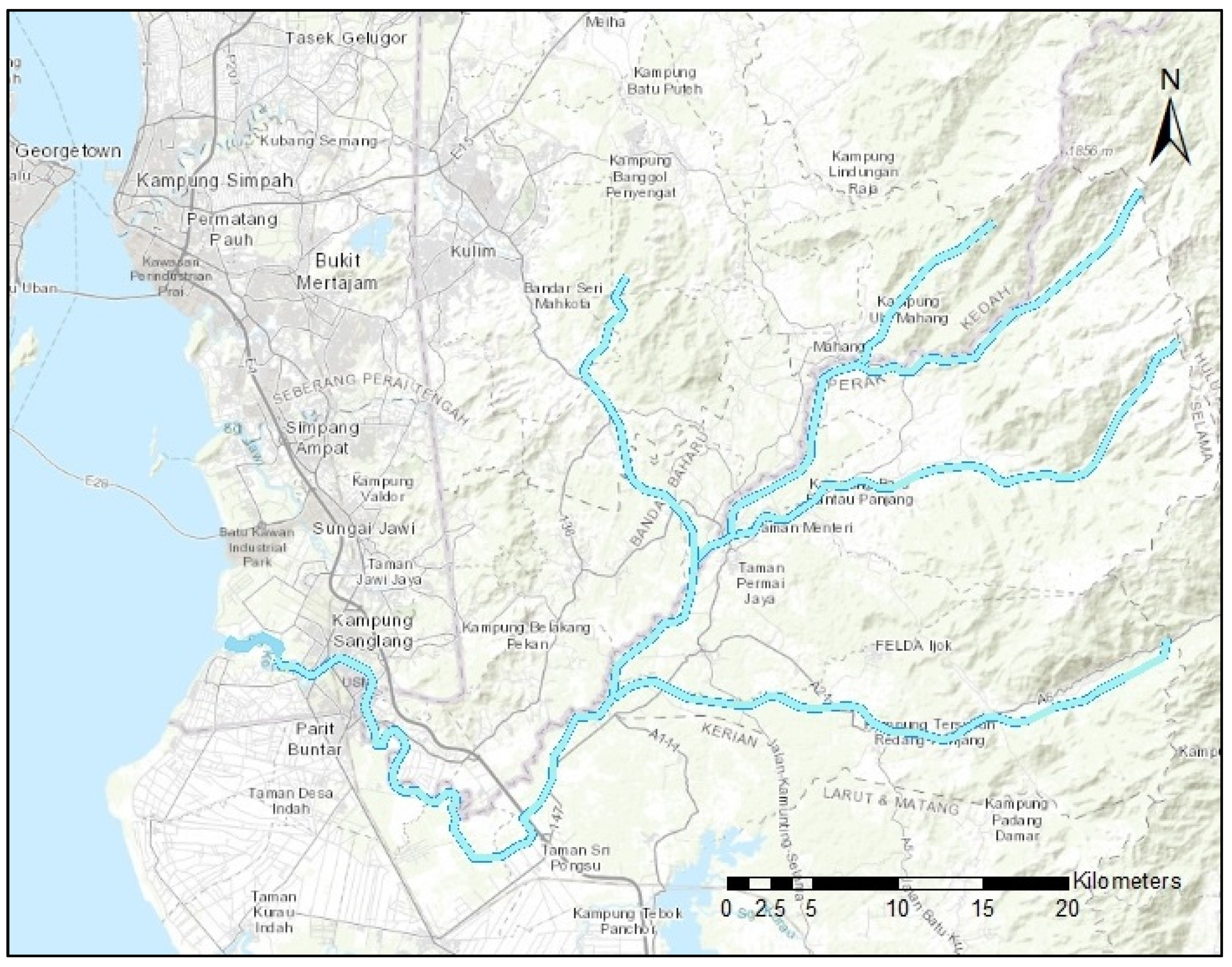
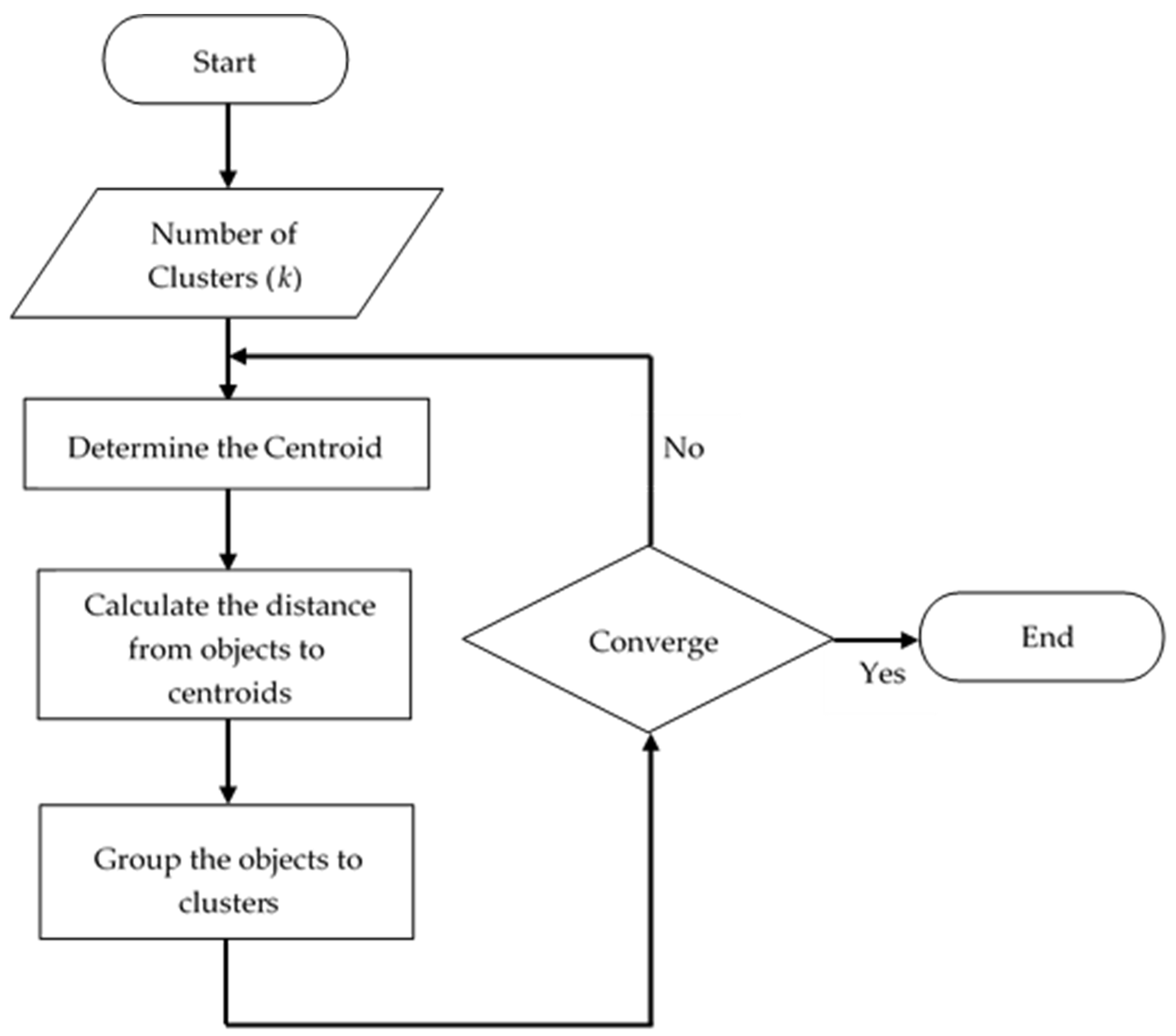
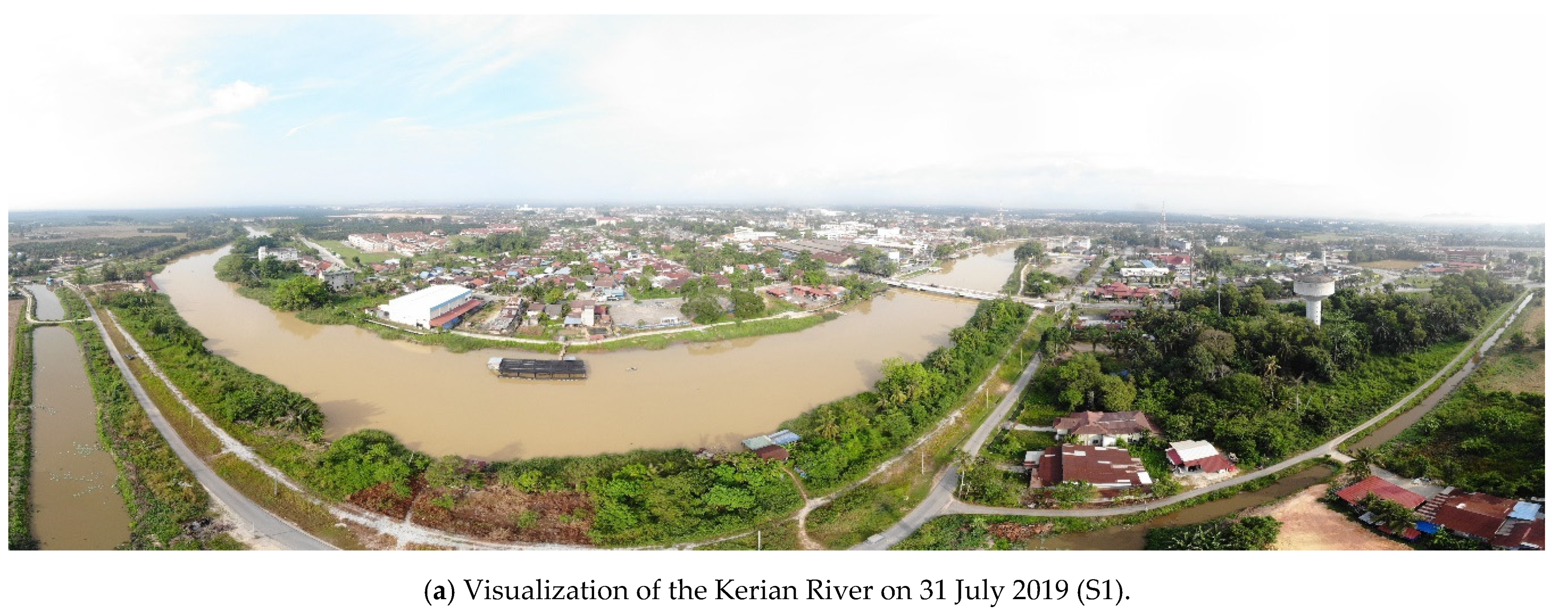
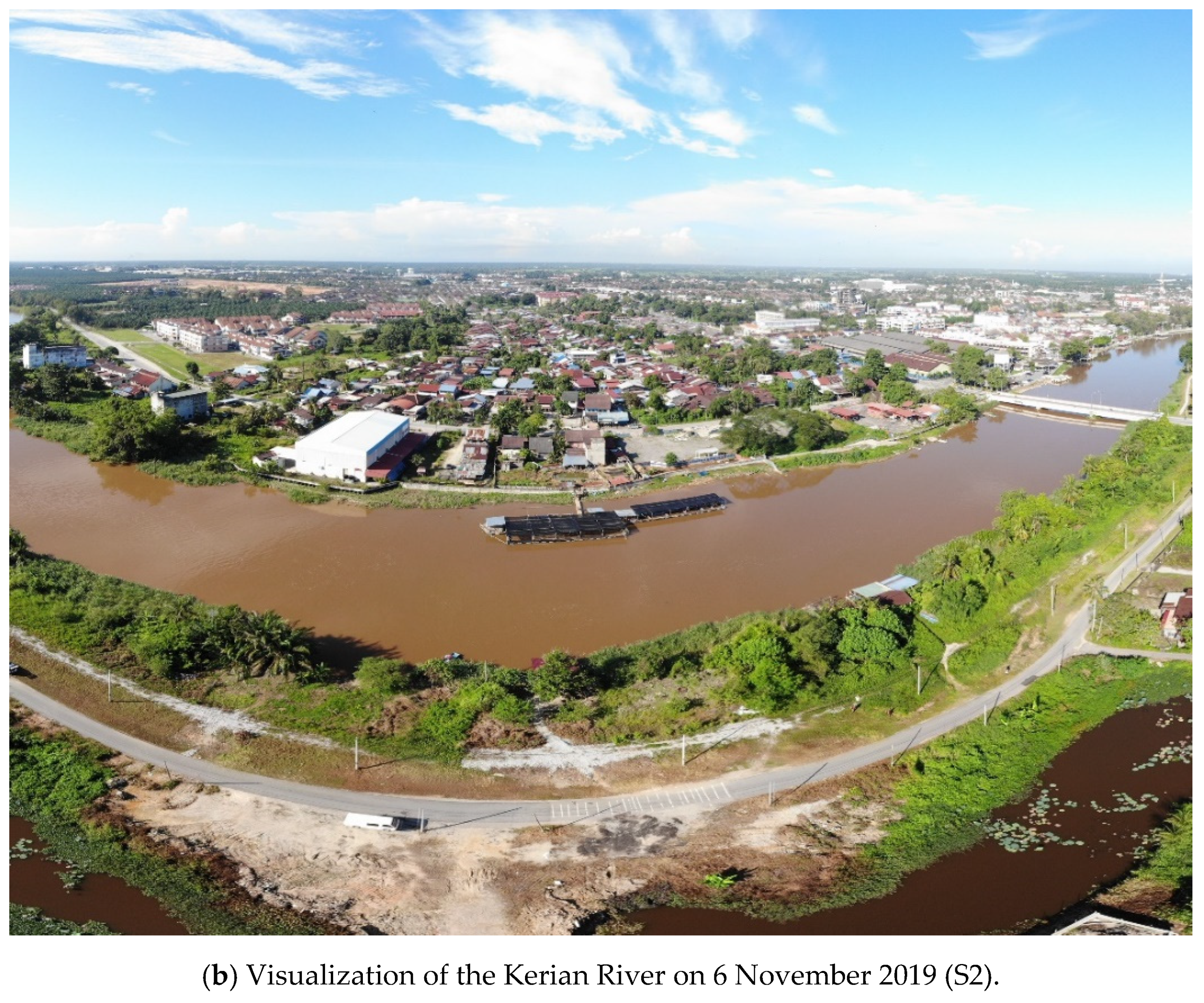

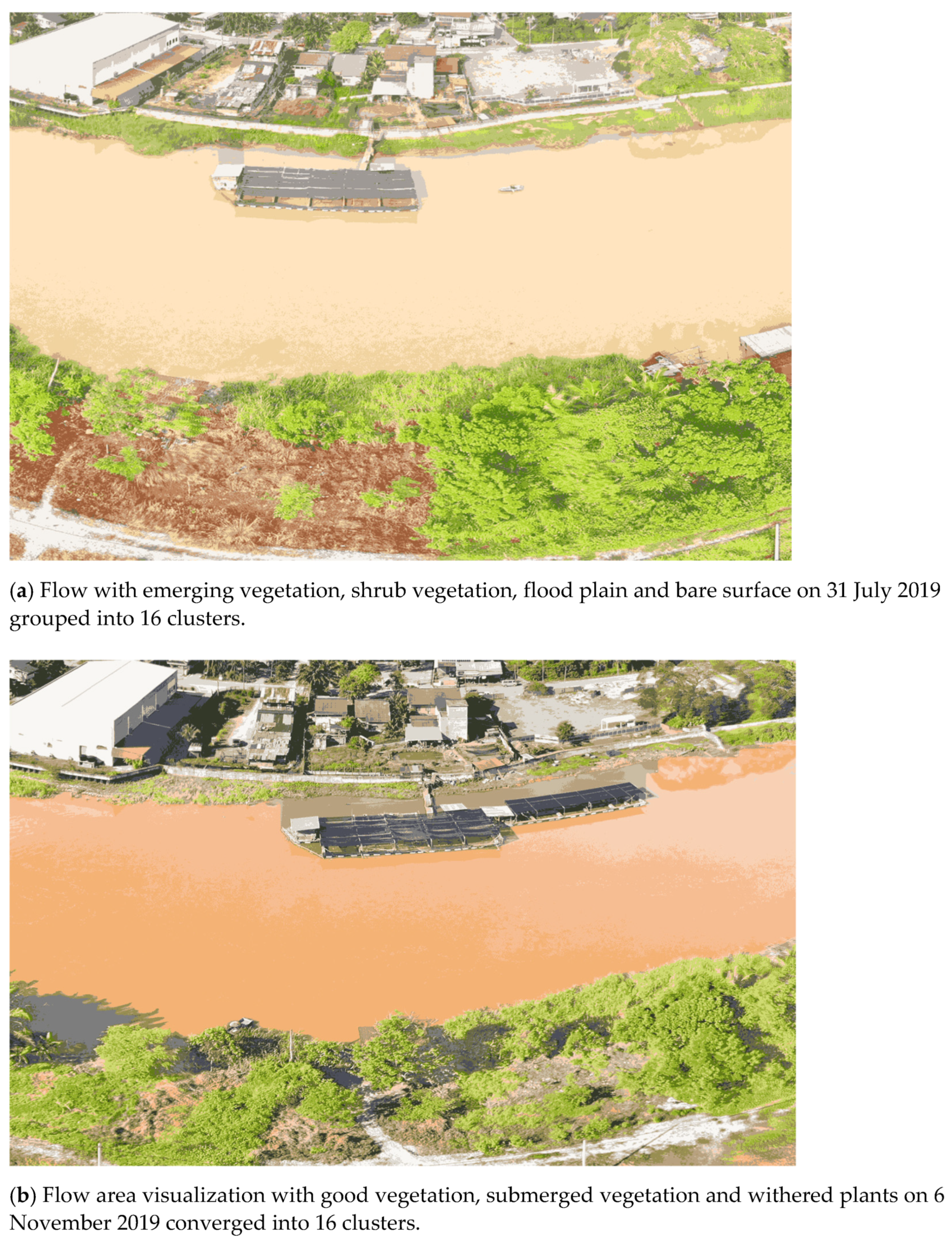
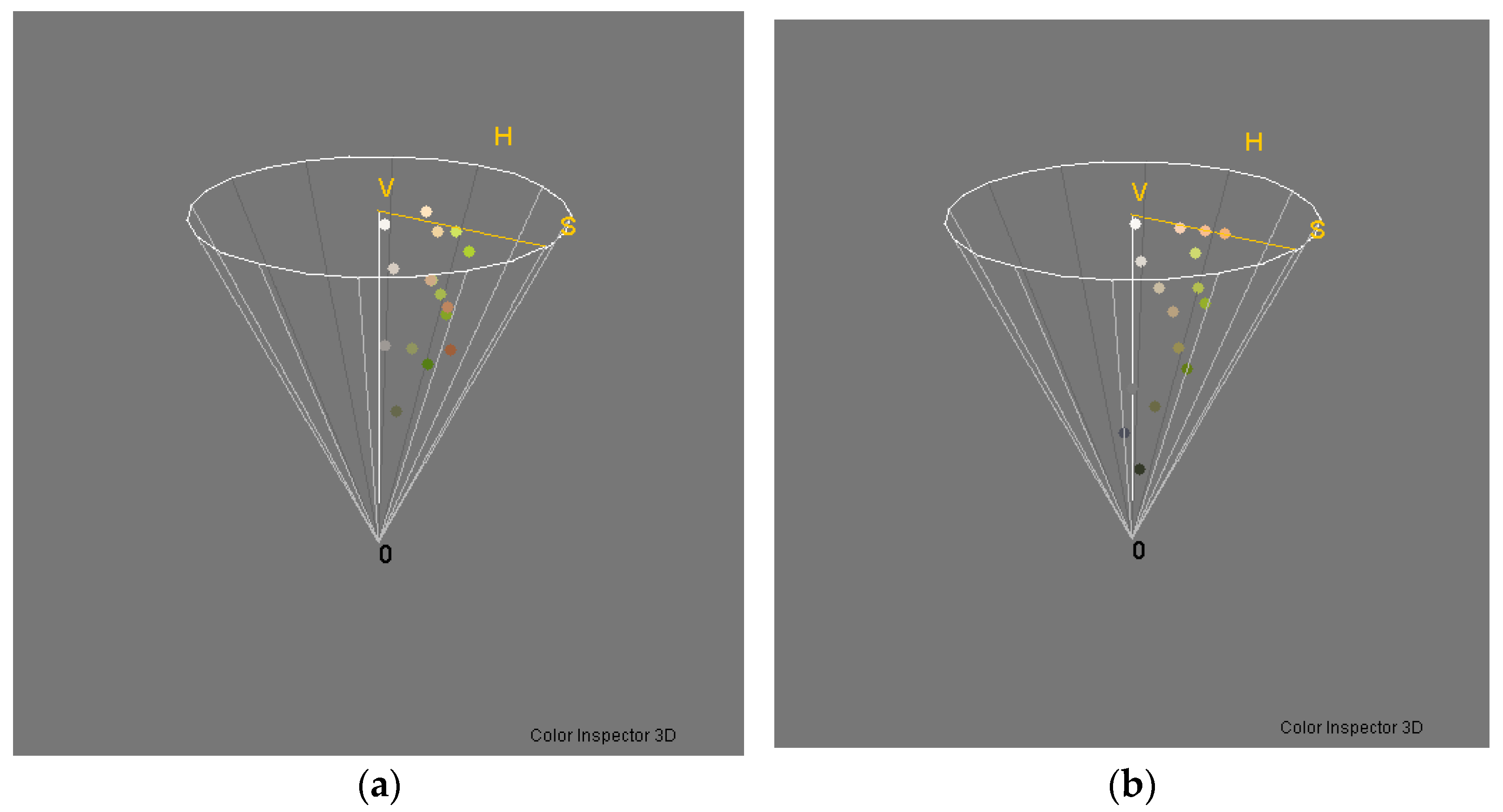
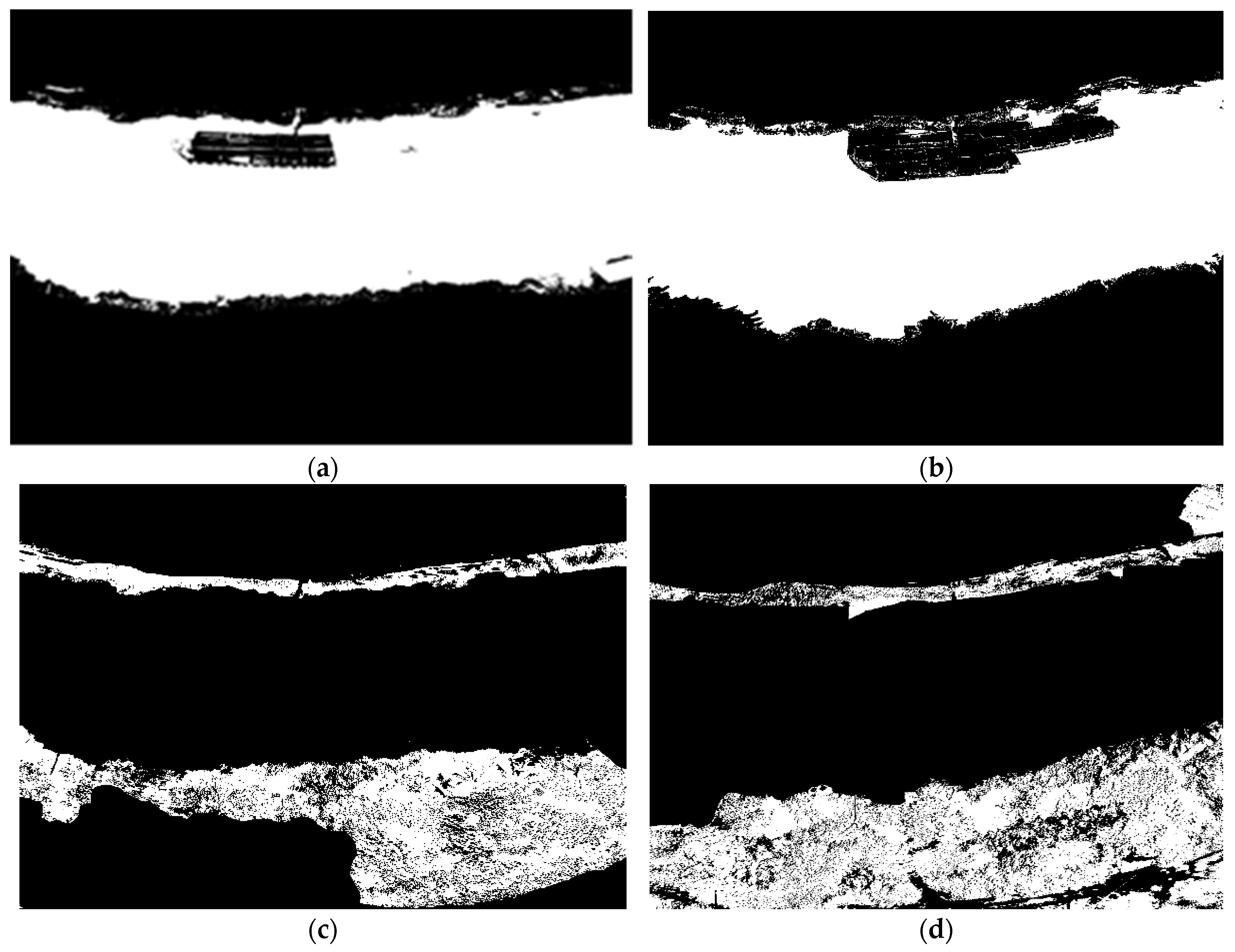
| Characteristics | DJI Mavic Pro Camera |
|---|---|
| Sensor Type | 1/2.3″ CMOS Sensor |
| Million Effective Pixels | 12.34 |
| Image Size | 4000 3000 |
| Lens | 35 mm |
| ISO range | 100–1600 |
| Site | Feature | Minimum Limits | Maximum Limits | ||||
|---|---|---|---|---|---|---|---|
| H () | S (%) | V (%) | H () | S (%) | V (%) | ||
| S1 | Flow Area | 34 | 24 | 100 | 38 | 31 | 94 |
| Vegetation | 64 | 10 | 40 | 83 | 62 | 89 | |
| S2 | Flow Area | 25 | 26 | 95 | 28 | 49 | 97 |
| Vegetation | 35 | 6 | 21 | 78 | 52 | 85 | |
| Site | Feature | White Pixels% (ROI) | Area (m2) |
|---|---|---|---|
| S1 | Flow Area | 39.441 | 4437.1 |
| Vegetation | 19.513 | 2195.2 | |
| S2 | Flow Area | 39.531 | 4447.2 |
| Vegetation | 25.314 | 2847.8 |
| Site | Feature | DSC | Jaccard Index |
|---|---|---|---|
| S1 | Flow Area | 97.86 | 94.36 |
| Vegetation | 94.91 | 92.20 | |
| S2 | Flow Area | 96.22 | 93.58 |
| Vegetation | 92.51 | 91.39 |
Publisher’s Note: MDPI stays neutral with regard to jurisdictional claims in published maps and institutional affiliations. |
© 2021 by the authors. Licensee MDPI, Basel, Switzerland. This article is an open access article distributed under the terms and conditions of the Creative Commons Attribution (CC BY) license (https://creativecommons.org/licenses/by/4.0/).
Share and Cite
Ansari, E.; Akhtar, M.N.; Abdullah, M.N.; Othman, W.A.F.W.; Bakar, E.A.; Hawary, A.F.; Alhady, S.S.N. Image Processing of UAV Imagery for River Feature Recognition of Kerian River, Malaysia. Sustainability 2021, 13, 9568. https://doi.org/10.3390/su13179568
Ansari E, Akhtar MN, Abdullah MN, Othman WAFW, Bakar EA, Hawary AF, Alhady SSN. Image Processing of UAV Imagery for River Feature Recognition of Kerian River, Malaysia. Sustainability. 2021; 13(17):9568. https://doi.org/10.3390/su13179568
Chicago/Turabian StyleAnsari, Emaad, Mohammad Nishat Akhtar, Mohamad Nazir Abdullah, Wan Amir Fuad Wajdi Othman, Elmi Abu Bakar, Ahmad Faizul Hawary, and Syed Sahal Nazli Alhady. 2021. "Image Processing of UAV Imagery for River Feature Recognition of Kerian River, Malaysia" Sustainability 13, no. 17: 9568. https://doi.org/10.3390/su13179568
APA StyleAnsari, E., Akhtar, M. N., Abdullah, M. N., Othman, W. A. F. W., Bakar, E. A., Hawary, A. F., & Alhady, S. S. N. (2021). Image Processing of UAV Imagery for River Feature Recognition of Kerian River, Malaysia. Sustainability, 13(17), 9568. https://doi.org/10.3390/su13179568







